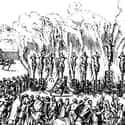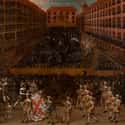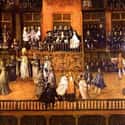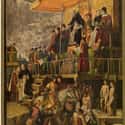-
(#6) Hundreds Of Thousands Of People Probably Went Through It
It is difficult to estimate the exact number of people who had to suffer through an auto de fé. Enactment of autos de fé varied by location and time. Some autos de fé were larger and more frenzied than others. But historians generally agree that in the heyday of the auto de fé, hundreds of thousands of people had to go through the dangerous, harmful, and humiliating ritual - and only the lucky ones survived.
-
(#13) Not Everyone Loved A Good Burning
By the 18th century, Europe was deep in the age known as the Enlightenment, a time when the values of tolerance and humanitarianism began to take root. But, progress wasn't universal; autos de fé persisted in many parts of Europe and its colonies into the 19th century. Voltaire, one of the leading figures of the French Enlightenment, was a fierce critic of autos de fé. He even satirized them in his anti-religious work Candide.
-
(#5) The Last Auto De Fé Was In 1850 In Mexico
Autos de fé may have been a product of the early modern world, but they outlasted it. The autos de fé developed in the late 15th and 16th centuries, and the Enlightenment of the 18th century slowed them down a little bit in some parts of the world. But they actually continued well into the 19th century. Though the Inquisition in Mexico was abolished in 1820, there is a record of an auto de fé there as late as 1850.
-
(#10) The Autos De Fé Were About Power
Autos de fé were about the spectators and the power of the Catholic Church as much as they were about the individual victims. The public spectacle of autos de fé meant that everyone could see what they considered to be holy justice unfolding before them. Sinners were obviously punished, and so they served as a cautionary tale to all the spectators. The pomp and circumstance of the spectacle also accentuated the power of the Church as an institution that could discipline and punish by whatever means it deemed fit.
-
(#9) Prisoners Were Kept In The Dark About Their Fate Until The Auto De Fé
Secrecy was central to the Inquisition proceedings. This meant that prisoners would endure their trials only to have to wait longer to hear their fate. Often, they had to wait several days through the pomp and circumstance of the auto de fé to finally hear their sentence. Officials did this to limit the number of appeals higher courts might receive in the wake of trials. But waiting to hear their fate proved too excruciating for some, and there are records of prisoners committing suicide before hearing their sentencing.
-
(#8) The Actual Public Ritual Could Last Hours
Though autos de fé often varied in size and scale, the most elaborate auto de fé spectacles were huge, public affairs. In Latin America, for example, these large-scale events took place over the course of several hours. Events would start the night before the spectacle, when a procession that included church officials and a choir marched through the streets. A second procession including civic officials and aristocrats happened the following morning. After the procession, spectators would utter an oath of loyalty, hear a sermon, and then watch the sentencing.
New Random Displays Display All By Ranking
About This Tool
Auto De Fe Atomic Portuguese is a public religious trial and confession ceremony in the Middle Ages. The Spanish Inquisition or the Portuguese Inquisition imposed penalties on pagans and heretics. In fact, most of the prisoners were executed by the secular authorities after the confession. The most common victims were former Jews and former Muslims who were apostates.
To understand the nature of the Inquisition, we must understand that the Middle Ages is indeed a backward era. The random tool explained 15 brutal facts about Auto De Fe that you never know, in the centuries that the Inquisition has existed, many improper trials have been conducted in the name of religion.
Our data comes from Ranker, If you want to participate in the ranking of items displayed on this page, please click here.















